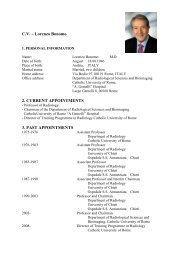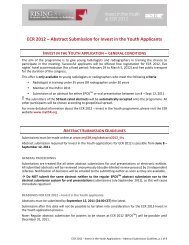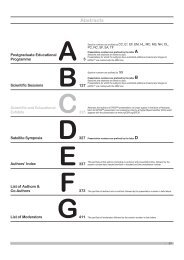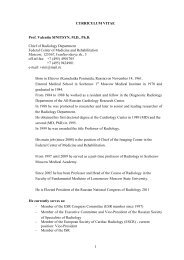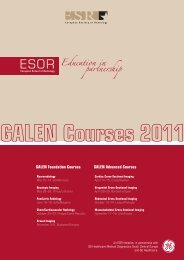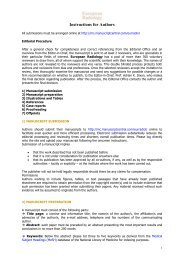Postgraduate Educational Programme - myESR.org
Postgraduate Educational Programme - myESR.org
Postgraduate Educational Programme - myESR.org
- No tags were found...
Create successful ePaper yourself
Turn your PDF publications into a flip-book with our unique Google optimized e-Paper software.
<strong>Postgraduate</strong> <strong>Educational</strong> <strong>Programme</strong>perform diagnostic imaging. Most of the time, clinical examination or electrophysiologicalstudy come before imaging and help to orientate the exploration. The firstpart of this course will address brachial plexus anatomy and pathology. The twofollowing parts will give an understanding on nerve anatomy and pathology of theupper and the lower limbs. Strengths and weaknesses of the two techniques willbe discussed.A-161 16:05A. Applied radiological anatomy and pathology of the brachial plexusS. Gerevini; Milan/IT (gerevini.simonetta@hsr.it)The Brachial Plexus (BP) originates from the ventral branches of the cervical nerveroots from C5 to T1.It comprises roots, trunks, divisions, cords, and branches,topographically divided into supraclavicular (roots and trunks), retroclavicular (divisions),and infraclavicular sections (cords and branches).The various divisions of thebrachial plexus appear as linear structures with low signal intensity on MR imagesobtained with all sequences and in all planes (especially sagittal and coronal). TheT1-weighted images optimally delineate normal nerve tracts from the musculatureand blood vessels, and show the size of the nerve. The nerves appear as elongatedfibers that are isointense to the scalene muscle in T1 weighted images, posteriorlyand superiorly to the curvilinear flow void of the subclavian artery. The generalabnormal findings include: loss of fat planes around BP components, diffuse orfocal enlargement of the nerves, hyperintensity of nerve signal on T2-weightedimages, focal or extensive Gadolinium uptake of the nerves on T1 fat-saturatedimages. Pathology of brachial plexus can be divided into non-traumatic and traumaticbrachial plexopathies. Post-actinic fibrosis is the most commonly reportednon-traumatic cause of brachial plexopaties, accounting for about 30% of cases,followed by metastatic breast cancer (20%) and primary or metastatic lung cancer(20%). Together, these three processes represent almost 70% of the explainablecauses of brachial plexopathies. The remaining cases are caused by a variety ofsituations ranging from benign and malignant tumours to inflammatory diseaseand Thoracic Outlet Disease.Learning Objectives:1. To understand the anatomy of the brachial plexus as demonstrated with MRI.2. To appreciate the range of pathology seen at the brachial plexus.3. To become familiar with the MRI findings of brachial plexus pathology.A-162 16:28B. Upper limb nerve entrapmentD. Weishaupt; Zurich/CH (dominik.weishaupt@triemli.zuerich.ch)The peripheral nerves of the upper limb are affected by a number of entrapmentand compression neuropathies. These syndromes involve the brachial plexus aswell as the musculocutaneous, axillary, suprascapular, ulnar, radial and mediannerves. Clinical examination and electrophysiological studies are traditionally themainstay of diagnostic work-up. However, ultrasonography and magentic resononanceimaging (MRI) may provide key information about the exact anatomic locationof the lesion or may help to narrow the differential diagnosis. In certain patients withthe diagnosis of a peripheral neuropathy, imaging using either ultrasononographyof MRI may help establish the cause of the condition and provide informationcrucial for conservative management or surgical planning. In addition, imaging isparticularly valuable in compex cases with discrepant nerve functions test results.Learning Objectives:1. To become familiar with the strengths and weaknesses of US and MRI forassessing upper limb nerves.2. To appreciate the imaging findings of upper limb nerve entrapment.A-163 16:51C. Lower limb nerve entrapmentC. Martinoli, A. Tagliafico; Genoa/IT (carlo.martinoli@libero.it)A variety of peripheral neuropathies can be encountered in the lower limb. Most areentrapment syndromes affecting many nerves, such as the sciatic, gluteal, femoral,lateral femoral cutaneous, obturator and pudendal around the hip, the peronealand its branches and the saphenous at the knee, the superficial peroneal at thelateral leg, the tibial with its plantar and calcanear branches at the ankle, the deepperoneal and the interdigital nerves in the foot. Although clinical examination andnerve conduction studies are the mainstays of the diagnostic work-up of peripheralneuropathies, ultrasound (US) and magnetic resonance (MR) imaging may providekey information about the exact anatomic location of a lesion and the nature of theconstricting finding or may help narrow the differential diagnosis. In patients withperipheral neuropathies of the lower extremity, US and MR imaging may providecritical information for planning an adequate treatment strategy. Although US andMR imaging have followed parallel paths for nerve imaging with little comparison ofthe two modalities, US seems to have some advantages over MR imaging, includinghigher spatial resolution, time effectiveness, the ability to explore long nerve segmentsin a single study and to examine tissues in both static and dynamic states.Learning Objectives:1. To become familiar with the strengths and weaknesses of US and MRI forassessing lower limb nerves.2. To appreciate the imaging findings of lower limb nerve entrapment.Panel discussion:Which on-going technological advances in MRI and US couldinfluence the way we image peripheral nerves in the future? 17:1416:00 - 17:30 Room E2Foundation Course: NeuroimagingE³ 720bInfection and inflammationModerator:A. Gouliamos; Athens/GRA-164 16:00A. InfectionE.T. Tali; Ankara/TR (turgut.tali@gmail.com)Cerebral infections can be caused by bacteria, fungi, parasites, viruses and prions.Radiological evaluation plays an important role in the diagnosis, subsequenttreatment and treatment monitoring. Cerebritis is characterised by poorly localisedperivascular inflammatory infiltrations with scattered necrosis, oedema, andpetechial haemorrhage. Radiological findings vary according to the stage of theinfection from oedema, mass effect, mild/patchy/heterogeneous enhancement ofcerebritis to ring-like lesions, with the capsule hypointense on T2WI, hyperintenseon T1WI, heterogeneous enhancement, central necrotic area, surrounding oedemaof abscesses. DWI shows high-signal intensity while ADC map shows low-signalintensity of the central necrotic area of the abscesses. MRS shows elevated lactateand amino acid peaks. Cystic lesions isointense to CSF are also seen with theparasitic infestations. Treatment can also be monitored mainly by MRI; decreasein oedema, in mass effect, and in the degree of enhancement, decreasing signalon DWI, increasing signal on ADC maps, gliosis, occasionally focal calcifications,turning of lactate and amino acid peaks to normal at MRS are the indicators ofsuccessful treatment. Imaging findings vary according to the causative fungus;from granuloma with hypointense signal on T2, abscess with rim enhancement,diffuse cerebritis with signal change and haemorrhages, haemorrhage, infarcts,enlarged perivascular space to gelatinous pseudocyst. Acute encephalitides arediffuse brain parenchymal inflammatory diseases mainly caused by viruses. Theycan also involve meninges. Pathologically the primary features of viral encephalitisinclude neuronal degeneration and inflammation with or without mass effect.Learning Objectives:1. To understand the concept of ‘leaky vessels’ in the infectious meningeal,parenchymal and ventricular involvement.2. To learn how to proceed with imaging when ‘time is of the essence’.3. To become familiar with the specific imaging patterns of bacterial, viral, fungal,parasitic and prion infections.A-165 16:30B. Multiple sclerosisF. Barkhof; Amsterdam/NL (f.barkhof@vumc.nl)MRI is often being used to demonstrate dissemination of lesions in the CNS inpatients with multiple sclerosis (MS). In the McDonald diagnostic criteria for MSthat rely more heavily on MRI than previously, a high specificity is warranted indemonstrating dissemination in space (DIS) and dissemination in time (DIT). Inthe 2010 updated criteria, DIS can be demonstrated by the presence of one ormore asymptomatic T2 lesions in minimally 2 of 4 crucial anatomical locations:juxtacortical, periventricular, infratentorial or in the spinal cord. Simultaneous presenceof asymptomatic gadolinium-enhancing and non-enhancing lesions at anytime is sufficient for demonstration of DIT, or any new lesion at follow‐up. MRI isalso used to initiate and monitor treatment efficacy and its side-effects (like PML).In addition, neurodegenerative features such as atrophy and black holes can bedetermined. The most common differential diagnosis of WM lesions in patientssuspected of MS are hypoxic-ischaemic white matter changes due to small vesseldisease (SVD). They are usually asymptomatic but can also present with migraine,S42AB C D E F G




